
Amateur Radio (see separate amateur radio page)
Travel (see separate travel page)

Before I became a fan, I had several brushes with "old time radio," a name given to recordings of network radio programs from the 1920s to the 1950s. Bill Miles, an old time radio program collector with whom I worked at KCOL in Fort Collins, Colorado, in 1969, gave me a reel-to-reel tape of programs, but they didn't interest me.
When I worked at KLAK in Lakewood, Colorado, in 1976, the station broadcast recordings of the 1950s radio series, "Gunsmoke" and "The Lone Ranger." Coincidentally, John Hart, who played the Lone Ranger on TV for a season or two, came by the station on a promotional tour for something I don't now recall. I later saw him perform on stage as the Lone Ranger at a Friends of Old Time Radio convention. But in the 1970s, I had no interest.
In the 1980s, I worked at KADX in Denver, where John Dunning hosted a program centered on rebroadcasts of old time radio shows and interviews with the actors. Dunning later authored two definitive books on the subject. I began listening to Dunning as his program moved from one station to another in following years.
In the early 1990s, while I was volunteering as the editor of Proceedings of the Radio Club of America, Durell Roth (K5KZQ) submitted an article about high-powered Mexican AM broadcast stations of the 1930s. I had occasion to see Durell at his home during a visit to Austin, Texas. In Durell's home office, I noticed a newsletter, "Hello Radio," that mentioned conventions involving old time radio.
Durell told me that several organizations held annual conventions and invited actors from the network radio era to attend and re-create programs on stage for the fans of the programs. The idea intrigued me, and I made arrangements to attend my first Friends of Old Time Radio convention in Newark, New Jersey.
Thanks to meeting other enthusiasts and a number of actors, I became a fan of the programs and began listening to them regularly. At first, that meant buying cassette tapes. Since the advent of streaming audio on the Internet, I mostly listen to the programs that way.
 | Maybe W.C. Fields is the best remembered of these stars, thanks to his films. Dorothy Lamour hosted "Sealtest Variety Theater" on radio and co-starred with Bob Hope and Bing Crosby in seven filmed "On the Road to ..." comedies. Charlie McCarthy was ventriloquist Edgar Bergen's most popular character. Bergen's radio program is among my favorites. Lamour's singing voice carries electricity all its own. | From left: W.C. Fields, Dorothy
Lamour, Charlie McCarthy, Edgar Bergen | |
No doubt about it, I like the comedies. A lot of the humor holds up well across five, six and even seven decades. Edgar Bergen's conversations with, well, himself, often are laugh-out-loud funny. When W.C. Fields appeared on the show, he and Charlie McCarthy would hurl funny insults at one another.
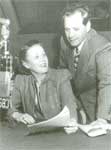 |  | 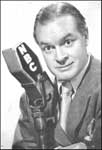 | 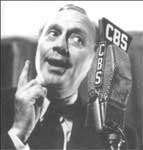 | | The Jordans | Fred Allen | Bob Hope | Jack Benny |
Jim and Marion Jordan played "Fibber McGee and Molly." The writer, Don Quinn, was fond of puns, and so am I, so we get along well. Fred Allen's humor is more topical, so it doesn't hold up as well in contemporary listening, but I always select his program if it is among those being streamed at any given time. Bob Hope is the master of the short, rapid-fire joke. He and Bing Crosby appeared on each other's shows fairly often, it seems. As a youngster, I saw Jack Benny on TV, probably in syndicated repeats, and as a guest on others' programs. I didn't grow to appreciate him until hearing his radio programs. His program and "Fibber McGee" are my very favorites.
 | 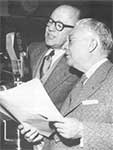 |  | 1928 WMAQ
Amos 'n' Andy | 1950s CBS
Amos 'n' Andy | Gosden and Correll, as "Sam 'n' Henry" on WGN around 1927. |
Freeman Gosden and Charles Correll played many of the characters on "Amos 'n' Andy." The judgment of history weighs on "Amos 'n' Andy" so heavily that the program seldom is rebroadcast. I don't think the nationally syndicated radio programs of the 1990s and 2000s such as "When Radio Was" or "Golden Age of Radio" played the show. I listen sometimes on streaming audio. Apparently, the program started as a daily 15-minute serial drama, with humor injected as occasional as comic relief to break the dramatic tension. The program converted into a weekly half-hour situation comedy in the 1940s, and those are the episodes that survive in available audio. Recordings of episodes from the 1930s, when the program was at its peak of popularity and it was a dramatic serial, apparently were destroyed as required by a syndication contract.
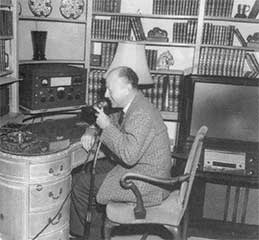 | Gosden, who played Amos on "Amos 'n' Andy," was an amateur radio operator, W6QUT. I don't think that's widely known.
And in the 1970s, I believe it was, I heard a radio amateur in the Midwest who had a routine in which he imitated "Amos 'n' Andy" characters. I don't remember who he was, but his imitation was good, and the ways he worked stories about amateur radio into his routine were funny. I wonder now who he was. | | W6QUT at home in Beverly Hills | |
Historians such as Elizabeth McLeod have looked into the history of "Amos 'n' Andy" in great depth.
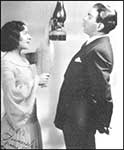 | 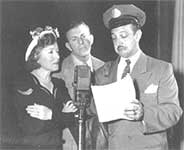 | 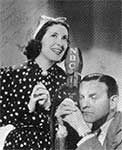 | | Burns and Allen | ... with Mel Blanc | |
George Burns and Gracie Allen also keep me laughing with their radio programs. The duo played 17 years on radio and another eight on TV. I remember at age seven or eight, sneaking out of my room past my bedtime to hide behind furniture and watch Burns and Allen as my parents watched them on TV. When they made me laugh, that gave me away, and it was back to bed. It's a pleasure to hear their polished act on recordings of their radio programs.

Silent movies caught my interest in the 1970s when I lived in Denver. A facility that I recall as being located in the downtown Denver area and that I think was called the Boettcher Center had a large auditorium on its main floor and a smaller screening room with limited seating in its basement. This smaller room, aptly named "Cinema," was where the center showed silent movies each week for a moderate price.
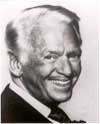 I remember that sometimes a screening would be accompanied by a lecture or other presentation, but I don't recall live music ever being offered. On one occasion, Douglas Fairbanks Jr. was there, and he spoke before and after the showing of a film he made when he was 18 years old. He said he didn't remember making the movie! Another later film of his was was shown after the first, but Fairbanks had left by the time the house lights came on again. I remember that sometimes a screening would be accompanied by a lecture or other presentation, but I don't recall live music ever being offered. On one occasion, Douglas Fairbanks Jr. was there, and he spoke before and after the showing of a film he made when he was 18 years old. He said he didn't remember making the movie! Another later film of his was was shown after the first, but Fairbanks had left by the time the house lights came on again.
My relocation to the Kansas City area brought an end to viewing silent films in theaters for a while. I don't like watching them on TV so much. Viewing a silent film gains something from a screening in a theater with others in the audience reacting to the movie.
In the 1990s, though, at least two organizations started screening silent films on an annual basis during one weekend each.
The Buster Keaton Celebration in Iola, Kansas offers films made by its namesake and usually films by one other selected film star each year.
The Kansas Silent Film Festival in Topeka, Kansas shows movies at the White Concert Hall on the Washburn University campus.
I've attended these events almost every year for quite a few years. Among other musical accompaniment, these events feature live music by the Mont Alto Motion Picture Orchestra that makes the silent movies even more enjoyable to watch.
The annual Pine Bluff Film Festival began in Pine Bluff, Arkansas in 1994, and I attended the fifth one on Oct. 3, 1998. What motivated me to make such a long drive was the extraordinary program that was offered.
On Friday, the festival screened The Wedding March, a 1928 silent film starring Erich von Stronheim and Fay Wray. The organizers secured the services of an orchestra leader from Los Angeles who scored music to accompany the movie based on bits and pieces of music that had survived from an original score. He led the Pine Bluff Symphony Orchestra, which included eight-to-12 musicians, as I recall. That's how I recall it, although historical information from the festival indicates that the orchestra was led by its usual conductor, Dr. Charles Evans.
The movie, by the way, had a segment filmed in color. That might have been the first time I knew that silent films had made any use of color. I later learned that a few silent films with stars who commanded a big box office draw were filmed in what was a highly expensive color process. The Wedding March had only a few minutes in color.
The new musical score and live accompaniment by such a large orchestra seemed ambitious enough for this new festival in little Pine Bluff, but the best part was that Fay Wray came to the event. She watched the Friday screening of The Wedding March, sitting in the front row near the orchestra. By 1998, it was exceedingly rare to find a silent film star in attendance at a festival. Born Sept. 15, 1907, Wray was 91 when she came to the festival.
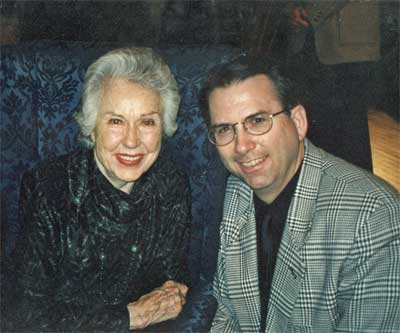 | On Saturday, Wray participated in an interview on stage and a question-and-answer session, and posed for photographs with fans. (Yep, I now have a photo of myself with Fay Wray.) Then the festival showed the 1933 version of King Kong in which Wray starred. |
| Fay Wray and Don Bishop, Pine Bluff Film Festival | |
I haven't heard much about the festival since then, partly my fault for not looking it up on the Internet, and partly the festival's fault for not maintaining a mailing list. I looked it up just now (June 2005), and I don't see that it has sponsored an event since the one it presented in 2001. Also, I'm not sure whether the festival had continued screening silent films.
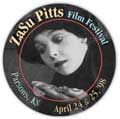 The ZaSu Pitts Film Festival in Parsons, Kansas, featured an appearance by Gale Storm at its third annual event in 2000, which I attended. It appears as though the festival fizzled out after its fifth outing in 2002. The community really supported this festival and made it a warm, personal experience. Parsons residents brought breads and cookies to sell in the lobby. When I went to lunch at a nearby restaurant, still wearing my nametag, a local couple asked to join me at my table. Many other locals did the same with other visitors, so this was an organized effort to welcome festival-goers and make them feel at home. I've seen nothing like it elsewhere. The ZaSu Pitts Film Festival in Parsons, Kansas, featured an appearance by Gale Storm at its third annual event in 2000, which I attended. It appears as though the festival fizzled out after its fifth outing in 2002. The community really supported this festival and made it a warm, personal experience. Parsons residents brought breads and cookies to sell in the lobby. When I went to lunch at a nearby restaurant, still wearing my nametag, a local couple asked to join me at my table. Many other locals did the same with other visitors, so this was an organized effort to welcome festival-goers and make them feel at home. I've seen nothing like it elsewhere.
Parsons had been struck by a tornado perhaps a week or two before the festival. Several businesses and 10 homes were destroyed. Lesser damage was evident elsewhere. But the festival organizers decided to go ahead, anyway, with a change in venue from the scheduled community college campus.
 Although Pitts starred in silent films as a dramatic actress, her voice led her to be cast in comedic roles in sound films. She also was known as Storm's sidekick Elvira "Nugey" Nugent in a 1950s TV series, Oh, Susanna! That's Storm on the left, next to Pitts, in a scene from the TV show. Pitts' "fluttery arms" and wavery voice have been said to have been the inspiration for the animated version of Olive Oyl in the Popeye the Sailor Man cartoons. Although Pitts starred in silent films as a dramatic actress, her voice led her to be cast in comedic roles in sound films. She also was known as Storm's sidekick Elvira "Nugey" Nugent in a 1950s TV series, Oh, Susanna! That's Storm on the left, next to Pitts, in a scene from the TV show. Pitts' "fluttery arms" and wavery voice have been said to have been the inspiration for the animated version of Olive Oyl in the Popeye the Sailor Man cartoons.
Storm made the rounds of film and radio festivals in 2000, at age 78. The week after the ZaSu Pitts Film Festival, she appeared at the Radio Classics Live event at Massasoit Community College in Brockton, Massachusetts. I attended Radio Classics Live once, but not that year. Later in 2000, I saw Storm again at Friends of Old Time Radio in Newark, New Jersey.
|


